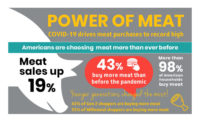Power of Meat showcases record-high retail meat sales
This year marks the 20th anniversary of the annual Power of Meat presentation.

Photo credit: Sammy Bredar
ORLANDO — This year marked the 20th anniversary of the annual Power of Meat presentation, offering in-depth insights on retail meat purchasing trends from 1,625 shoppers and market examples featuring more than 120 stores from more than 15 countries.
On March 24 at the 2025 Annual Meat Conference in Orlando, 210 Analytics Principal Anne-Marie Roerink presented findings from the most recent edition of the Power of Meat. The study, conducted on behalf of FMI – the Food Industry Association and the Meat Institute’s Foundation for Meat and Poultry Research and Education, includes data from Circana and is sponsored by Cryovac.
While many 94% of consumers are concerned about today's cost of living, shoppers are still coming to the meat department, and more often than they used to. Total 2024 sales for the meat department reached $105 billion, up 4.7% in sales and 2.3% in pounds from the year prior. The meat department is supported by the strong deli aisle, reaching $56 billion for 2024, an increase of 3% from the year prior.
Grinds had a very strong year, with ground beef representing 85% of grind sales. In addition to ground beef, ground turkey and chicken had strong growth in both dollars and pounds. Deli-prepared meat had strong growth, up 10.8% in dollar sales and 12.8% in units. Frozen meat was another strong point this year, reaching $14 billion in sales, up 6% in dollar sales and up 5.9% in pounds sold from 2023.
This was a record-setting year for the meat department, showcasing the resilience of the industry in a difficult economic environment. Despite consumers tightening their wallets, they are buying meat more often. Circana data shows shoppers buy meat more than once per week. Roerink noted that these additional trips, combined with a slight increase in spending, have been driving industry growth.
Fresh beef had a very strong 2024, up 6.7% in sales from 2023 to $73 billion, and up 3.2% in pounds to 16.4 billion. Beef was the strongest sales driver, but lamb had greater growth in pounds sold. The lamb industry reached $895 million in sales, up 5.2% in dollars and 12.2% in pounds. With the strength of the lamb category, Roerink predicts it will be a $1 million industry within the next year.
Private brands are still outperforming store brands, with private brands up 2.3% in pounds sold from the year prior, and store brands declining 0.1% in pounds. This aligns with current consumer demand for value. As private brands continue to utilize premium offerings, they remain a strong competitor to store brands.
During the Power of Meat presentation, multiple consumers stated they did not know what "regenerative" meant, and went so far as to say the term could mean "lab-grown meat." While consumer misinformation might be frustrating for the meat and poultry industries, the opportunity to educate more consumers on the benefits of meat consumption creates a strong opportunity for companies that practice regenerative agriculture, as they can prioritize consumer education on key claims.
Packaging offers an effective way to connect with and educate consumers on production claims and nutritional attributes, but as Roerink noted in her presentation, the package can quickly turn into a NASCAR situation, cluttering the package with too many claims to be legible. To combat this issue, companies can get creative with consumer education outside of the package, or they can utilize QR codes to link to additional education.
Health and wellness are driving much of the food industry, and the meat industry has an opportunity to capitalize on this. Roerink noted that many young consumers are searching out simple, clean ingredients. Many meat products, especially fresh meat offerings, cater to consumer demand for simple, minimal ingredients, as well as nutritional benefits.
As millenials become more influential in the shopping aisle, retailers and producers must pay attention to generational differences for meat purchasing trends. Millenials and baby boomers have different preferences for meat products, and they have different marketing preferences as well. When in the store, Millenials tend to prioritize price per unit and pound, nutrition and product claims. Baby boomers tend to prioritize price per pound, quality and package price. While there are similarities between these two groups' priorities, millenials gaining spending power indicates a need to focus more on nutrition and product claims.
Most US households buy meat products according to Circana data, and 73% think meat is generally a health food choice. As health and wellness continue to trend, protein is becoming increasingly important to consumers at the store. When consumers were asked what food they consider to be excellent sources of protein, many cited eggs, chicken and beef. Only 53% of consumers responded with pork. The pork industry and the meat industry in general have yet another education opportunity within this space.
Shifting purchasing preferences are indicating strong consumer demand for value and premiumization. Roerink noted that, in the Power of Meat survey, chicken and grinds came out on top, along with organic- grass-fed and other premium offerings. Consumers are constantly balancing demand for premium items with persisting demand for value. When seeking out value products, many shoppers are turning to larger package sizes.
Looking for a reprint of this article?
From high-res PDFs to custom plaques, order your copy today!





